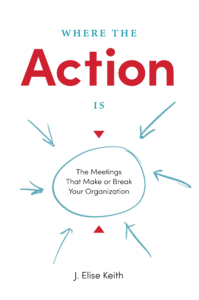 Say the word “meetings” to business people outside the events industry and probably what comes to mind are those small staff gatherings that happen on a daily basis in offices all over the world. They also might groan. In Where the Action Is: Meetings That Make or Break Your Organization, author J. Elise Keith sets out to take some of the pain away. Here are the six competencies of high-performing meetings she shares in her book:
Say the word “meetings” to business people outside the events industry and probably what comes to mind are those small staff gatherings that happen on a daily basis in offices all over the world. They also might groan. In Where the Action Is: Meetings That Make or Break Your Organization, author J. Elise Keith sets out to take some of the pain away. Here are the six competencies of high-performing meetings she shares in her book:
1. Know the meeting’s purpose and desired outcome. If you can’t define a meeting’s specific objective, you’re better off just canceling it, Keith writes. “Clarify the purpose and desired outcomes. Why are you meeting, and what is the meeting meant to accomplish? Your meeting may look pretty, but it doesn’t do anything useful.”
2. Structure meetings to achieve the desired outcome. This shouldn’t be confused with providing an agenda for the meeting. “For many meetings that’s a good idea, but it isn’t always necessary,” Keith writes. When meeting organizers talk about “structure,” they typically only consider the timing for which different topics will be discussed. But Keith says it is also important to consider how you’ll invite attendees, how you’ll arrange the meeting room, how attendees will introduce themselves, and how the group will make decisions during the meeting. “All of these factors,” she writes, “make up the structure of the meeting.”
3. Respect the time that people invest. Starting and ending a meeting on time, as well as sharing the time within the meeting fairly among participants so everyone has an opportunity to speak, shows that the meeting organizer respects participants’ busy schedules. Considerate leaders, according to Keith, plan meetings in such a way that it will minimize disruption to other work — i.e., not wasting time during the meeting complaining about work, holding side conversations, or interrupting others. Skilled meeting planners will also avoid inviting and thereby inconveniencing employees whose attendance is not completely necessary.
4. Structure meetings for engagement. Before a meeting begins, the organizer should have an idea of how everyone present will contribute to the outcome. “People enjoy meetings they actively participate in more, and when everyone actively participates, the meeting often creates a higher positive impact on the organization,” Keith writes. For optimal engagement, meeting leaders should make sure participants are provided with any pre-reading material they need in order to feel properly prepped beforehand. “Happily, when people come informed and ready,” she says, “you’ll also get a better result in the end.”
5. Take visible notes. Sometimes, it’s tough to tell what kind of progress is actually being made in meetings. If the meeting organizer takes notes that everyone can see, participants are more likely to feel productive and motivated during the meeting. “Visual agendas and note-taking improve engagement, clarify outcomes, and,” according to Keith, “increase the meeting’s potential positive impact.”
6. Publish meeting records where everyone can find them. “When you centralize meeting records, the organization owns the results,” Keith writes. Though it may sound counterintuitive, meeting organizers should not want attendees to feel as though they must attend every meeting. Centralized notes save those who weren’t able to attend from FOMO. Not only that, she writes, centralized notes “make it possible to build on results, reuse successful meeting designs, and keep meetings small.”

